 | –≠–ª–µ–∫—Ç—Ä–æ–Ω–Ω—ã–π –∫–æ–º–ø–æ–Ω–µ–Ω—Ç: X9221AUPI | –°–∫–∞—á–∞—Ç—å:  PDF PDF  ZIP ZIP |

1
Æ
X9221A
64 Taps, 2-Wire Serial Bus
Dual Digitally Controlled Potentiometer
(XDCPTM)
FEATURES
∑ Two XDCPs in one package
∑ 2-wire serial interface
∑ Register oriented format, 8 registers total
--Directly write wiper position
--Read wiper position
--Store as many as four positions per pot
∑ Instruction format
--Quick transfer of register contents to resistor
array
∑ Direct write cell
--Endurance≠100,000 writes per bit per register
∑ Resistor array values
--2k
, 10k
, 50k
∑ Resolution: 64 taps each pot
∑ 20 Ld plastic DIP and 20-lead SOIC packages
∑ Pb-free plus anneal available (RoHS compliant)
DESCRIPTION
The X9221A integrates two digitally controlled potenti-
ometers (XDCP) on a monolithic CMOS integrated
microcircuit.
The digitally controlled potentiometer is implemented
using 63 resistive elements in a series array. Between
each element are tap points connected to the wiper
terminal through switches. The position of the wiper on
the array is controlled by the user through the 2-wire
bus interface. Each potentiometer has associated with
it a volatile Wiper Counter Register (WCR) and 2 non-
volatile Data Registers (DR0:DR1) that can be directly
written to and read by the user. The contents of the
WCR controls the position of the wiper on the resistor
array through the switches. Power up recalls the con-
tents of DR0 to the WCR.
The XDCP can be used as a three-terminal potentiom-
eter or as a two-terminal variable resistor in a wide
variety of applications including control, parameter
adjustments, and signal processing.
BLOCK DIAGRAM
R1
R0
R3
R2
V
H0
/R
H0
V
L0
/R
L0
V
W0
/R
W0
Wiper
Counter
Register
(WCR)
Register
Array
Pot 1
Wiper
Counter
Register
(WCR)
R1
R0
R3
R2
8
Data
SCL
SDA
A0
A1
A2
A3
Interface
and
Control
Circuitry
V
CC
V
SS
Pot 0
V
H1
/R
H1
V
L1
/R
L1
V
W1
/R
W1
CAUTION: These devices are sensitive to electrostatic discharge; follow proper IC Handling Procedures.
1-888-INTERSIL or 1-888-468-3774
|
Intersil (and design) is a registered trademark of Intersil Americas Inc.
XDCP is a trademark of Intersil Americas Inc. Copyright Intersil Americas Inc. 2005. All Rights Reserved
All other trademarks mentioned are the property of their respective owners.
Data Sheet
FN8163.1
September 14, 2005
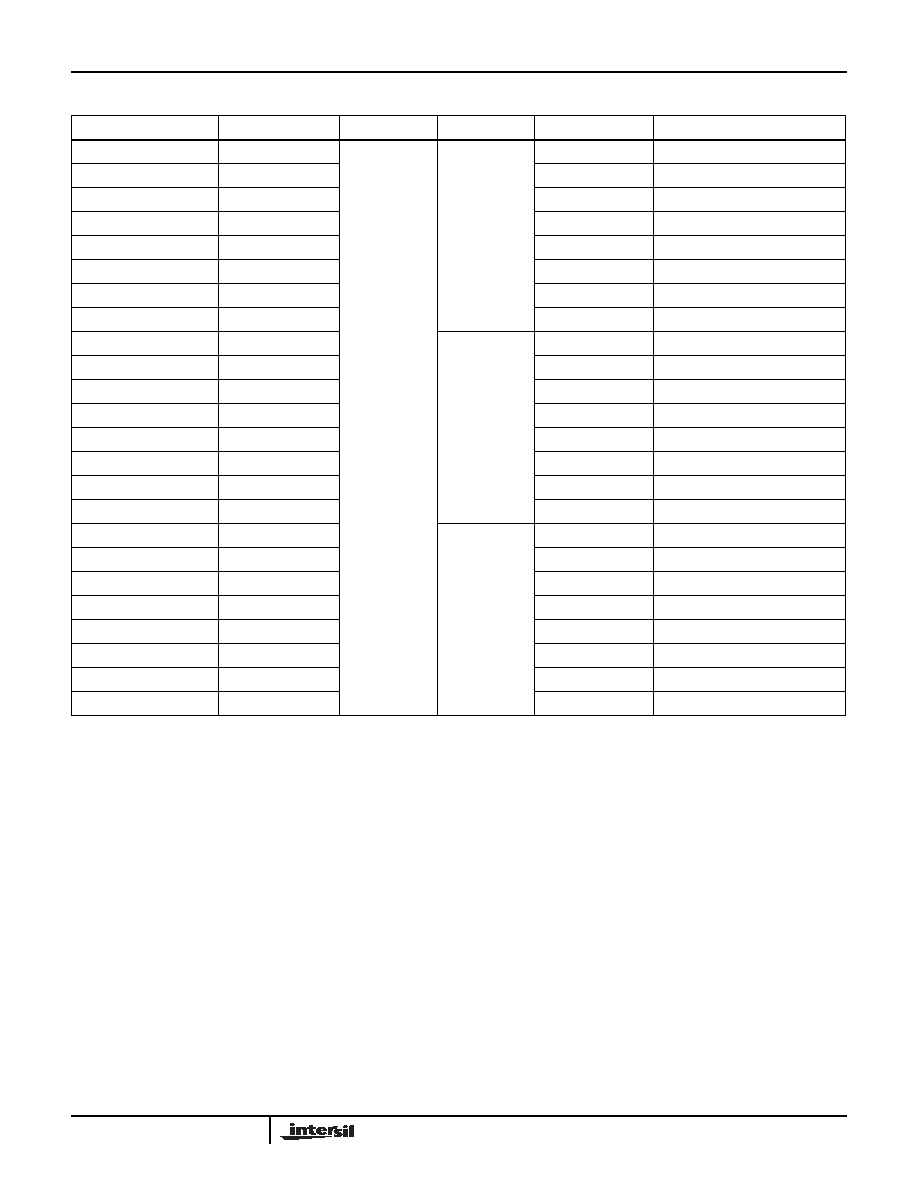
2
FN8163.1
September 14, 2005
Ordering Information
PART NUMBER
PART MARKING
V
CC
LIMITS (V)
R
TOTAL
(K)
TEMP RANGE (∞C)
PACKAGE
X9221AYP
X9221AYP
5 ±10%
2
0 to 70
20 Ld PDIP
X9221AYPZ (Note)
X9221AYP Z
0 to 70
20 Ld PDIP (Pb-free)
X9221AYPI
X9221AYPI
-40 to 85
20 Ld PDIP
X9221AYPIZ (Note)
X9221AYPI Z
-40 to 85
20 Ld PDIP (Pb-Free)
X9221AYS*
X9221AYS
0 to 70
20 Ld SOIC (300MIL)
X9221AYSZ* (Note)
X9221AYS Z
0 to 70
20 Ld SOIC (300MIL) (Pb-Free)
X9221AYSI*
X9221AYSI
-40 to 85
20 Ld SOIC (300MIL)
X9221AYSIZ* (Note)
X9221AYSI Z
-40 to 85
20 Ld SOIC (300MIL) (Pb-Free)
X9221AWP
X9221AWP
10
0 to 70
20 Ld PDIP
X9221AWPZ (Note)
X9221AWP Z
0 to 70
20 Ld PDIP (Pb-Free)
X9221AWPI
X9221AWPI
-40 to 85
20 Ld PDIP
X9221AWPIZ (Note)
X9221AWPI Z
-40 to 85
20 Ld PDIP (Pb-Free)
X9221AWS*
X9221AWS
0 to 70
20 Ld SOIC (300MIL)
X9221AWSZ* (Note)
X9221AWS Z
0 to 70
20 Ld SOIC (300MIL) (Pb-Free)
X9221AWSI*
X9221AWSI
-40 to 85
20 Ld SOIC (300MIL)
X9221AWSIZ* (Note)
X9221AWSI Z
-40 to 85
20 Ld SOIC (300MIL) (Pb-Free)
X9221AUP
X9221AUP
50
0 to 70
20 Ld PDIP
X9221AUPZ (Note)
X9221AUP Z
0 to 70
20 Ld PDIP (Pb-Free)
X9221AUPI
X9221AUPI
-40 to 85
20 Ld PDIP
X9221AUPIZ (Note)
X9221AUPI Z
-40 to 85
20 Ld PDIP (Pb-Free)
X9221AUS*
X9221AUS
0 to 70
20 Ld SOIC (300MIL)
X9221AUSZ* (Note)
X9221AUS Z
0 to 70
20 Ld SOIC (300MIL) (Pb-Free)
X9221AUSI*
X9221AUSI
-40 to 85
20 Ld SOIC (300MIL)
X9221AUSIZ* (Note)
X9221AUSI Z
-40 to 85
20 Ld SOIC (300MIL) (Pb-Free)
*Add "T1" suffix for tape and reel.
NOTE: Intersil Pb-free plus anneal products employ special Pb-free material sets; molding compounds/die attach materials and 100% matte tin plate
termination finish, which are RoHS compliant and compatible with both SnPb and Pb-free soldering operations. Intersil Pb-free products are MSL
classified at Pb-free peak reflow temperatures that meet or exceed the Pb-free requirements of IPC/JEDEC J STD-020.
X9221A

3
FN8163.1
September 14, 2005
PIN DESCRIPTIONS
Host Interface Pins
Serial Clock (SCL)
The SCL input is used to clock data into and out of the
X9221A.
Serial Data (SDA)
SDA is a bidirectional pin used to transfer data into
and out of the device. It is an open drain output and
may be wire-ORed with any number of open drain or
open collector outputs. An open drain output requires
the use of a pull-up resistor. For selecting typical val-
ues, refer to the guidelines for calculating typical val-
ues on the bus pull-up resistors graph.
Address
The Address inputs are used to set the least signifi-
cant 4 bits of the 8-bit slave address. A match in the
slave address serial data stream must be made with
the Address input in order to initiate communication
with the X9221A
Potentiometer Pins
V
H
/R
H
(V
H0
/R
H0
-V
H1
/R
H1
), V
L
/R
L
(V
L0
/R
L0
-V
L1
/R
L1
)
The V
H
/R
H
and V
L
/R
L
inputs are equivalent to the ter-
minal connections on either end of a mechanical
potentiometer.
V
W
/R
W
(V
W0
/R
W0
-V
W1
/R
W1
)
The wiper outputs are equivalent to the wiper output of
a mechanical potentiometer.
PIN CONFIGURATION
PIN NAMES
PRINCIPLES OF OPERATION
The X9221A is a highly integrated microcircuit incor-
porating two resistor arrays, their associated registers
and counters and the serial interface logic providing
direct communication between the host and the XDCP
potentiometers.
Serial Interface
The X9221A supports a bidirectional bus oriented pro-
tocol. The protocol defines any device that sends data
onto the bus as a transmitter and the receiving device
as the receiver. The device controlling the transfer is a
master and the device being controlled is the slave.
The master will always initiate data transfers and pro-
vide the clock for both transmit and receive operations.
Therefore, the X9221A will be considered a slave
device in all applications.
Clock and Data Conventions
Data states on the SDA line can change only during
SCL LOW periods (t
LOW
). SDA state changes during
SCL HIGH are reserved for indicating start and stop
conditions.
Start Condition
All commands to the X9221A are preceded by the
start condition, which is a HIGH to LOW transition of
SDA while SCL is HIGH (t
HIGH
). The X9221A continu-
ously monitors the SDA and SCL lines for the start
condition, and will not respond to any command until
this condition is met.
Stop Condition
All communications must be terminated by a stop con-
dition, which is a LOW to HIGH transition of SDA while
SCL is HIGH.
V
W0
/R
W0
V
L0
/R
L0
V
H0
/R
L0
A0
A2
V
W1
/R
W1
V
L1
/R
L1
V
H1
/R
H1
SDA
V
SS
1
2
3
4
5
6
7
8
9
10
20
19
18
17
16
15
14
13
12
11
V
CC
RES
RES
RES
A1
A3
SCL
RES
RES
RES
DIP/SOIC
X9221A
Symbol
Description
SCL
Serial Clock
SDA
Serial Data
A0≠A3
Address
V
H0
/R
H0
-V
H1
/R
H1
,
V
L0
/R
H0
-V
L1
/R
L0
Potentiometers
(terminal equivalent)
V
W0
/R
W0
-V
W1
/R
W1
Potentiometers
(wiper equivalent)
RES
Reserved (Do not connect)
X9221A
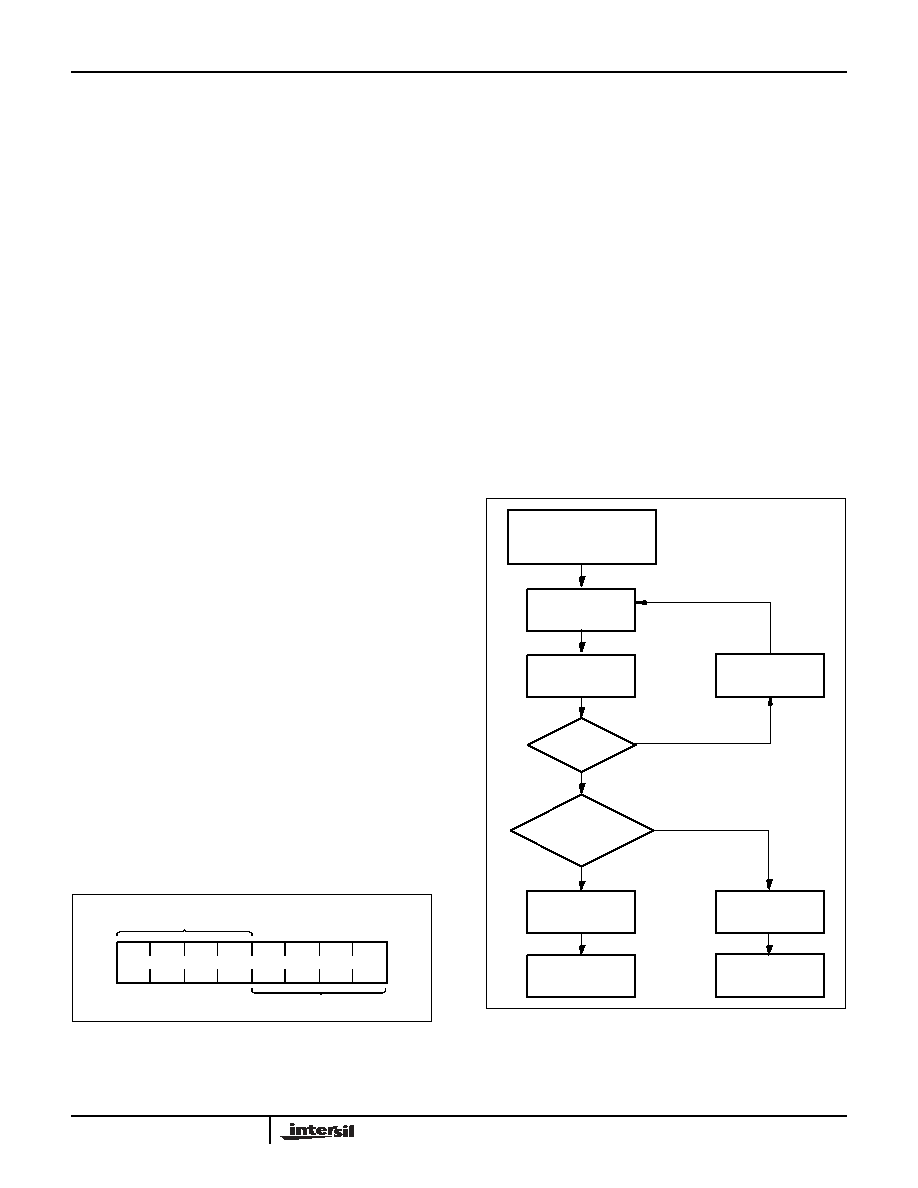
4
FN8163.1
September 14, 2005
Acknowledge
Acknowledge is a software convention used to provide
a positive handshake between the master and slave
devices on the bus to indicate the successful receipt of
data. The transmitting device, either the master or the
slave, will release the SDA bus after transmitting eight
bits. The master generates a ninth clock cycle and
during this period the receiver pulls the SDA line LOW
to acknowledge that it successfully received the eight
bits of data. See Figure 7.
The X9221A will respond with an acknowledge after
recognition of a start condition and its slave address
and once again after successful receipt of the com-
mand byte. If the command is followed by a data byte
the X9221A will respond with a final acknowledge.
Array Description
The X9221A is comprised of two resistor arrays. Each
array contains 63 discrete resistive segments that are
connected in series. The physical ends of each array
are equivalent to the fixed terminals of a mechanical
potentiometer (V
H
/R
H
and V
L
/R
L
inputs).
At both ends of each array and between each resistor
segment is a FET switch connected to the wiper
(V
W
/R
W
) output. Within each individual array only one
switch may be turned on at a time. These switches are
controlled by the Wiper Counter Register (WCR). The
six least significant bits of the WCR are decoded to
select, and enable, one of sixty-four switches.
The WCR may be written directly, or it can be changed
by transferring the contents of one of four associated
data registers into the WCR. These data registers and
the WCR can be read and written by the host system.
Device Addressing
Following a start condition the master must output the
address of the slave it is accessing. The most signifi-
cant four bits of the slave address are the device type
identifier (refer to Figure 1 below). For the X9221A this
is fixed as 0101[B].
Figure 1. Slave Address
The next four bits of the slave address are the device
address. The physical device address is defined by
the state of the A0-A3 inputs. The X9221A compares
the serial data stream with the address input state; a
successful compare of all four address bits is required
for the X9221A to respond with an acknowledge.
Acknowledge Polling
The disabling of the inputs, during the internal nonvol-
atile write operation, can be used to take advantage of
the typical 5ms EEPROM write cycle time. Once the
stop condition is issued to indicate the end of the non-
volatile write command the X9221A initiates the inter-
nal write cycle. ACK polling can be initiated
immediately. This involves issuing the start condition
followed by the device slave address. If the X9221A is
still busy with the write operation no ACK will be
returned. If the X9221A has completed the write oper-
ation an ACK will be returned and the master can then
proceed with the next operation.
Flow 1. ACK Polling Sequence
1
0
0
A3
A2
A1
A0
Device Type
Identifier
Device Address
1
Nonvolatile Write
Command Completed
Enter ACK Polling
Issue
START
Issue Slave
Address
ACK
Returned?
Further
Operation?
Issue
Instruction
Proceed
Issue STOP
NO
YES
YES
Proceed
Issue STOP
NO
X9221A

5
FN8163.1
September 14, 2005
Instruction Structure
The next byte sent to the X9221A contains the instruc-
tion and register pointer information. The four most
significant bits are the instruction. The next four bits
point to one of two pots and when applicable they
point to one of four associated registers. The format is
shown below in Figure 2.
Figure 2. Instruction Byte Format
t
The four high order bits define the instruction. The
sixth bit (P0) selects which one of the two potentiome-
ters is to be affected by the instruction. The last two
bits (R1 and R0) select one of the four registers that is
to be acted upon when a register oriented instruction
is issued.
Four of the nine instructions end with the transmission
of the instruction byte. The basic sequence is illus-
trated in Figure 3. These two-byte instructions
exchange data between the WCR and one of the data
registers. A transfer from a data register to a WCR is
essentially a write to a static RAM. The response of
the wiper to this action will be delayed t
STPWV
. A
transfer from WCR's current wiper position to a data
register is a write to nonvolatile memory and takes a
minimum of t
WR
to complete. The transfer can occur
between either potentiometer and their associated
registers or it may occur between both of the potenti-
ometers and one of their associated registers.
Four instructions require a three-byte sequence to
complete. These instructions transfer data between
the host and the X9221A; either between the host and
one of the data registers or directly between the host
and the WCR. These instructions are: Read WCR,
read the current wiper position of the selected pot;
Write WCR, change current wiper position of the
selected pot; Read Data Register, read the contents of
the selected nonvolatile register; Write Data Register,
write a new value to the selected data register. The
sequence of operations is shown in Figure 4.
The Increment/Decrement command is different from
the other commands. Once the command is issued
and the X9221A has responded with an acknowledge,
the master can clock the selected wiper up and/or
down in one segment steps; thereby, providing a fine
tuning capability to the host. For each SCL clock pulse
(t
HIGH
) while SDA is HIGH, the selected wiper will
move one resistor segment towards the V
H
/R
H
termi-
nal. Similarly, for each SCL clock pulse while SDA is
LOW, the selected wiper will move one resistor seg-
ment towards the V
L
/R
L
terminal. A detailed illustra-
tion of the sequence and timing for this operation are
shown in Figures 5 and 6 respectively.
Figure 3. Two-Byte Command Sequence
I1
I2
I3
I0
0
P0
R1
R0
Potentiometer
Select
Register
Select
Instructions
S
T
A
R
T
0
1
0
1
A3 A2 A1 A0
A
I3
I2
I1
I0
0
P0 R1 R0
SCL
SDA
S
T
O
P
C
K
A
C
K
X9221A
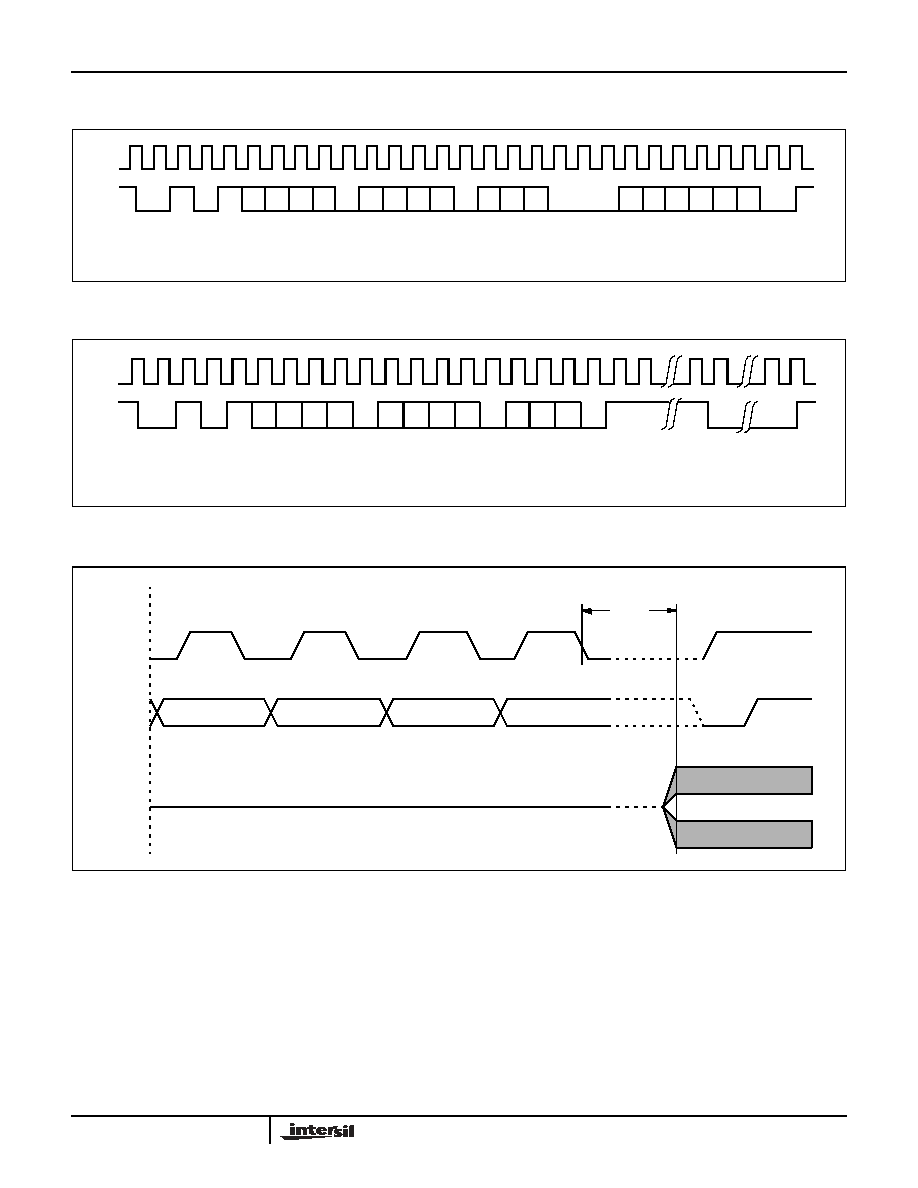
6
FN8163.1
September 14, 2005
Figure 4. Three-Byte Command Sequence
Figure 5. Increment/Decrement Command Sequined
e
Figure 6. Increment/Decrement Timing Limits
S
T
A
R
T
0
1
0
1 A3 A2 A1 A0 A
I3 I2
I1 I0
0 P0 R1 R0
SCL
SDA
S
T
O
P
0
0
D5 D4 D3 D2 D1 D0
C
K
A
C
K
A
C
K
S
T
A
R
T
0
1
0
1 A3 A2 A1 A0
I3
I2
I1 I0
0
P0 R1 R0
SCL
SDA
S
T
O
P
X
X
I
N
C
1
I
N
C
2
I
N
C
n
D
E
C
1
D
E
C
n
A
C
K
A
C
K
SCL
SDA
V
W
/R
W
INC/DEC
CMD
Issued
Voltage Out
t
CLWV
X9221A
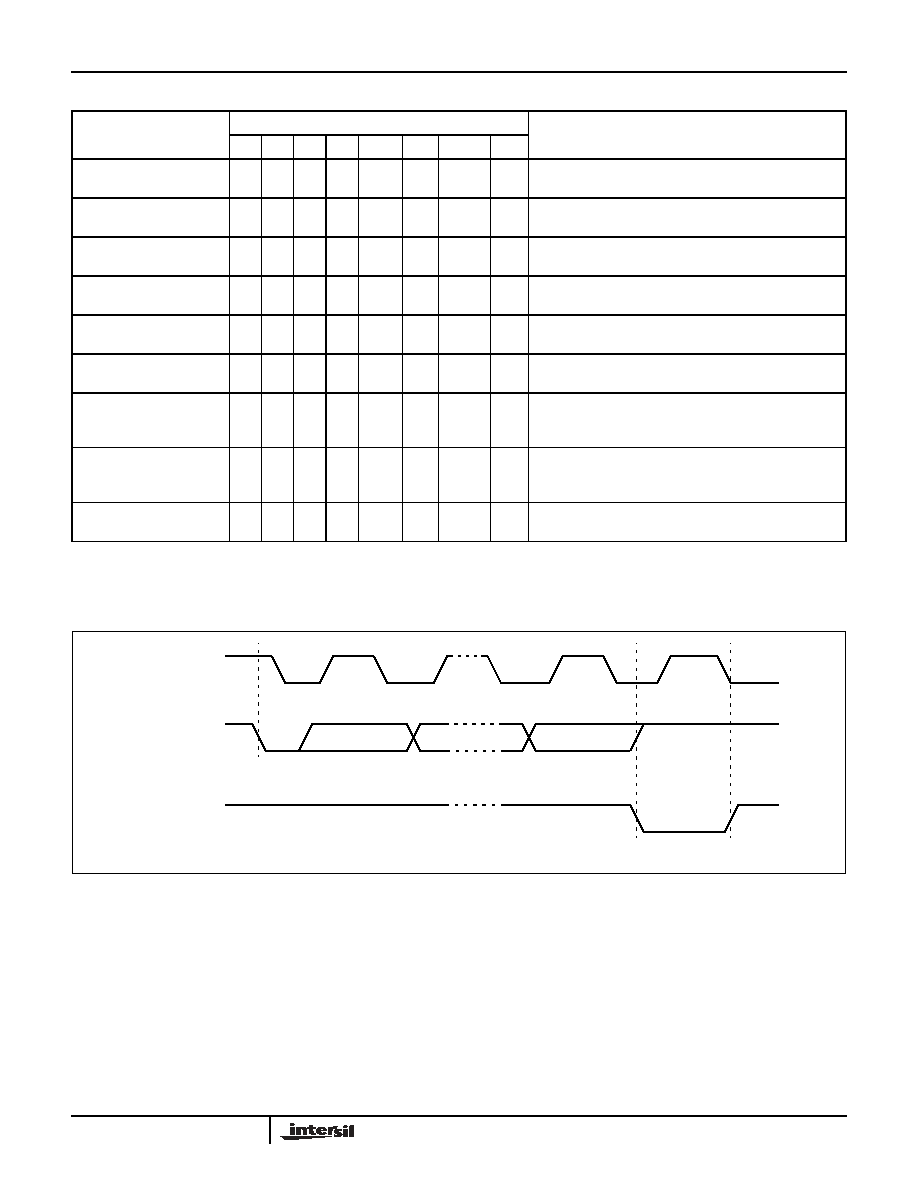
7
FN8163.1
September 14, 2005
Table 1. Instruction Set
Note: (7) N/A = Not applicable or don't care; that is, a data register is not involved in the operation and need not be addressed (typical)
Figure 7. Acknowledge Response from Receiver
Instruction
Instruction Format
Operation
I
3
I
2
I
1
I
0
0
P
0
R
1
R
0
Read WCR
1
0
0
1
0
1/0 N/A
(7)
N/A Read the contents of the Wiper Counter Register
pointed to by P
0
Write WCR
1
0
1
0
0
1/0
N/A
N/A Write new value to the Wiper Counter Register
pointed to by P
0
Read Data Register
1
0
1
1
0
1/0
1/0
1/0
Read the contents of the Register pointed to by
P
0
and R
1
≠R
0
Write Data Register
1
1
0
0
0
1/0
1/0
1/0
Write new value to the Register pointed to by P
0
and R
1
≠R
0
XFR Data Register to
WCR
1
1
0
1
0
1/0
1/0
1/0
Transfer the contents of the Register pointed to
by P
0
and R
1
≠R
0
to its associated WCR
XFR WCR to Data
Register
1
1
1
0
0
1/0
1/0
1/0
Transfer the contents of the WCR pointed to by
P
0
to the Register pointed to by R
1
≠R
0
Global XFR Data
Register to WCR
0
0
0
1
N/A
N/A
1/0
1/0
Transfer the contents of the Data Registers
pointed to by R
1
≠R
0
of both pots to their
respective WCR
Global XFR WCR
to Data Register
1
0
0
0
N/A
N/A
1/0
1/0
Transfer the contents of all WCRs to their
respective data Registers pointed to by R
1
≠R
0
of both pots
Increment/Decrement
Wiper
0
0
1
0
0
1/0
N/A
N/A Enable Increment/decrement of the WCR point-
ed to by P
0
SCL from
Data Output
1
8
9
START
Acknowledge
Master
from Transmitter
Data Output
from Receiver
X9221A

8
FN8163.1
September 14, 2005
DETAILED OPERATION
Both XDCP potentiometers share the serial interface
and share a common architecture. Each potentiometer
is comprised of a resistor array, a wiper counter regis-
ter and four data registers. A detailed discussion of the
register organization and array operation follows.
Wiper Counter Register
The X9221A contains two wiper counter registers
(WCR), one for each XDCP potentiometer. The WCR
can be envisioned as a 6-bit parallel and serial load
counter with its outputs decoded to select one of sixty-
four switches along its resistor array. The contents of
the WCR can be altered in four ways: it may be written
directly by the host via the Write WCR instruction
(serial load); it may be written indirectly by transferring
the contents of one of four associated data registers
via the XFR Data Register instruction (parallel load); it
can be modified one step at a time by the Increment/
Decrement instruction; finally, it is loaded with the con-
tents of its data register zero (R0) upon power-up.
The WCR is a volatile register; that is, its contents are
lost when the X9221A is powered-down. Although the
register is automatically loaded with the value in R0
upon power-up, it should be noted this may be differ-
ent from the value present at power-down.
Data Registers
Each potentiometer has four nonvolatile data regis-
ters. These can be read or written directly by the host
and data can be transferred between any of the four
data registers and the WCR. It should be noted all
operations changing data in one of these registers is a
nonvolatile operation and will take a maximum of
10ms.
If the application does not require storage of multiple
settings for the potentiometer, these registers can be
used as regular memory locations that could possibly
store system parameters or user preference data.
Figure 8. Detailed Potentiometer Block Diagram
Serial Data Path
From Interface
Circuitry
Register 0
Register 1
Register 2
Register 3
Serial
Bus
Input
Parallel
Bus
Input
Wiper
Counter
Register
INC/DEC
Logic
UP/DN
CLK
Modified SCL
UP/DN
V
H
/R
H
If WCR = 00[H] then V
W
/R
W
= V
L
/R
L
If WCR = 3F[H] then V
W
/R
W
= V
H
/R
H
8
6
C
D
e
o
u
n
t
e
r
e
c
o
d
V
L
/R
L
V
W
/R
W
X9221A

9
FN8163.1
September 14, 2005
ABSOLUTE MAXIMUM RATINGS
Temperature Under Bias ................... -65∞C to +135∞C
Storage Temperature ........................ -65∞C to +150∞C
Voltage on SCK, SCL or Any Address
Input With Respect to V
SS
...................... -1V to +7V
Voltage on Any V
H
/R
H
, V
W
/R
W
or V
L
/R
L
Referenced to V
SS
................................. +6V / -4.3V
V = |V
H
/R
H
≠V
L
/R
L
|........................................... 10.3V
Lead Temperature (soldering, 10 seconds)....... 300∞C
I
W
(10s) ..............................................................±6mA
COMMENT
Stresses above those listed under "Absolute Maximum
Ratings" may cause permanent damage to the device.
This is a stress rating only; functional operation of the
device (at these or any other conditions above those
indicated in the operational sections of this specifica-
tion) is not implied. Exposure to absolute maximum
rating conditions for extended periods may affect
device reliability.
ANALOG CHARACTERISTICS (Over recommended operating conditions unless otherwise stated.)
Symbol
Parameter
Limits
Test Conditions
Min.
Typ.
Max.
Unit
R
TOTAL
End to End Resistance
-20
+20
%
Power Rating
50
mW
25∞C, each pot
I
W
Wiper Current
-3
+3
mA
R
W
Wiper Resistance
40
130
Wiper Current = ±1mA
V
TERM
Voltage on any V
H
/R
H
, V
W
/R
W
or
V
L
/R
L
Pin
-3.0
+5
V
Noise
120
dBV
Ref: 1V
Resolution 1.6
%
See
Note
5
Absolute Linearity
(1)
-1
+1
MI
(3)
V
w(n)(actual -
V
w(n)(expected)
Relative Linearity
(2)
-0.2
+0.2
MI
(3)
V
w(n + 1)
- [V
w(n) + MI
]
Temperature Coefficient
±300
ppm/∞C See Note 5
Radiometric Temperature Coefficient
±20
ppm/∞C See Note 5
C
H
/C
L
/C
W
Potentiometer Capacitances
10/10/25
pF
See circuit #3
RECOMMENDED OPERATING CONDITIONS
Temp
Min.
Max.
Commercial
0
∞
C
+70
∞
C
Industrial
-40
∞
C
+85
∞
C
Supply Voltage
Limits
X9221A
5V ± 10%
X9221A

10
FN8163.1
September 14, 2005
D.C. OPERATING CHARACTERISTICS (Over recommended operating conditions unless otherwise stated.)
Notes: (1) Absolute Linearity is utilized to determine actual wiper voltage versus expected voltage as determined by wiper position when used as
a potentiometer.
(2) Relative Linearity is utilized to determine the actual change in voltage between two successive tap positions when used as a potenti-
ometer. It is a measure of the error in step size.
(3) MI = RTOT/63 or (V
H
/R
H
≠V
L
/R
L
)/63, single pot
ENDURANCE AND DATA RETENTION
CAPACITANCE
POWER-UP TIMING
Notes: (5) This parameter is periodically sampled and not 100% tested.
(6) t
PUR
and t
PUW
are the delays required from the time V
CC
is stable until the specified operation can be initiated. These parameters are
periodically sampled and not 100% tested.
Power Up Requirements (Power up sequencing can affect correct recall of the wiper registers)
The preferred power-on sequence is as follows: First V
CC
, then the potentiometer pins. It is suggested that V
CC
reach 90% of its final value before power is applied to the potentiometer pins. The V
CC
ramp rate specification should
be met, and any glitches or slope changes in the V
CC
line should be held to <100mV if possible. Also, V
CC
should not
reverse polarity by more than 0.5V.
Symbol
Parameter
Limits
Test Conditions
Min. Typ.
Max.
Unit
l
CC
Supply Current (Active)
3
mA
f
SCL
= 100kHz, SDA = Open, Other Inputs = V
SS
I
SB
V
CC
Current (Standby)
200
500
µA
SCL = SDA = V
CC
, Addr. = V
SS
I
LI
Input Leakage Current
10
µA
V
IN
= V
SS
to V
CC
I
LO
Output Leakage Current
10
µA
V
OUT
= V
SS
to V
CC
V
IH
Input HIGH Voltage
2
V
CC
+ 1
V
V
IL
Input LOW Voltage
-1
0.8
V
V
OL
Output LOW Voltage
0.4
V
I
OL
= 3mA
Parameter
Min.
Unit
Minimum endurance
100,000
Data changes per bit per register
Data retention
100
years
Symbol
Parameter
Max.
Unit
Test Conditions
C
I/O
(5)
Input/output capacitance (SDA)
8
pF
V
I/O
= 0V
C
IN
(5)
Input capacitance (A0, A1, A2, A3 and SCL)
6
pF
V
IN
= 0V
Symbol
Parameter
Min.
Max.
Unit
t
PUR
(6)
Power-up to initiation of read operation
1
ms
t
PUW
(6)
Power-up to initiation of write operation
5
ms
t
R
V
CC
V
CC
Power-up ramp rate
0.2
50
V/msec
X9221A

11
FN8163.1
September 14, 2005
A.C. CONDITIONS OF TEST
SYMBOL TABLE
Equivalent A.C. Test Circuit
Circuit #3 SPICE Macro Model
Guidelines for Calculating Typical Values of Bus
Pull-Up Resistors
Input pulse levels
V
CC
x 0.1 to V
CC
x 0.9
Input rise and fall times
10ns
Input and output timing levels
V
CC
x 0.5
WAVEFORM
INPUTS
OUTPUTS
Must be
steady
Will be
steady
May change
from LOW
to HIGH
Will change
from LOW
to HIGH
May change
from HIGH
to LOW
Will change
from HIGH
to LOW
Don't Care:
Changes
Allowed
Changing:
State Not
Known
N/A
Center Line
is High
Impedance
5V
1533
100pF
SDA Output
R
H
C
H
10pF
C
W
R
L
C
L
R
W
R
TOTAL
25pF
10pF
Macro Model
120
100
80
40
60
20
20 40 60
80 100 120
0
0
Bus Capacitance (pF)
Min.
Resistance
Max.
Resistance
R
MAX
=
C
BUS
t
R
R
MIN
=
I
OL MIN
V
CC MAX
=1.8k
R
esistan
ce (k
)
X9221A
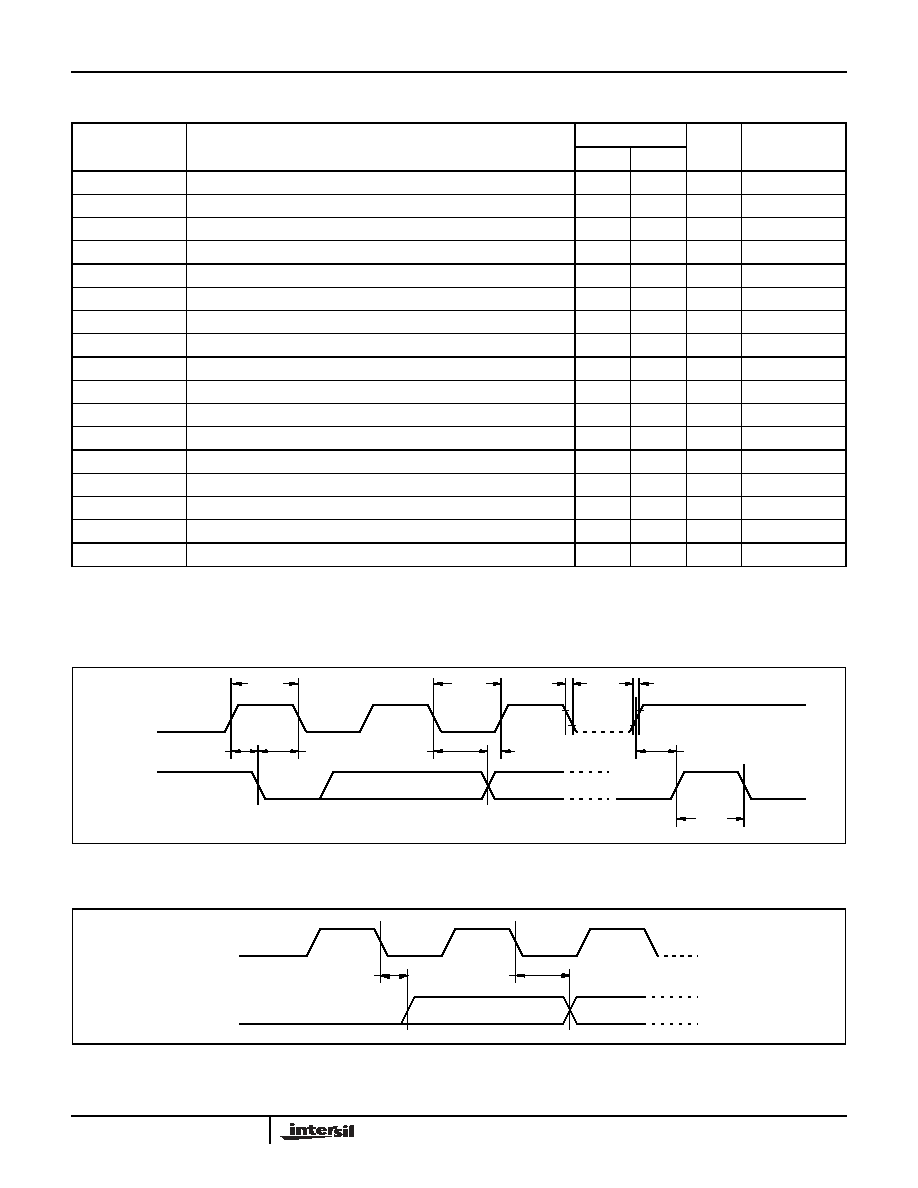
12
FN8163.1
September 14, 2005
TIMING DIAGRAMS
Figure 10. Input Bus Timing
Figure 11. Output Bus Timing
A.C. CHARACTERISTICS (Over recommended operating conditions unless otherwise stated)
Symbol
Parameter
Limits
Unit
Reference
Figure
Min.
Max.
f
SCL
SCL clock frequency
0
100
kHz
10
t
LOW
Clock LOW period
4700
ns
10
t
HIGH
Clock HIGH period
4000
ns
10
t
R
SCL and SDA rise time
1000
ns
10
t
F
SCL and SDA fall time
300
ns
10
T
i
Noise suppression time constant (glitch filter)
100
ns
10
t
SU:STA
Start condition setup time (for a repeated start condition)
4700
ns
10 & 12
t
HD:STA
Start condition hold time
4000
ns
10 & 12
t
SU:DAT
Data in setup time
250
ns
10
t
HD:DAT
Data in hold time
0
ns
10
t
AA
SCL LOW to SDA data out valid
300
3500
ns
11
t
DH
Data out hold time
300
ns
11
t
SU:STO
Stop condition setup time
4700
ns
10 & 12
t
BUF
Bus free time prior to new transmission
4700
ns
10
t
WR
Write cycle time (nonvolatile write operation)
10
ms
13
t
STPWV
Wiper response time from stop generation
1000
µs
13
t
CLWV
Wiper response from SCL LOW
500
µs
6
t
HIGH
t
SU:STA
t
HD:STA
t
HD:DAT
t
SU:DAT
t
LOW
t
F
t
SU:STO
t
R
t
BUF
SCL
SDA
(Data in)
t
AA
t
DH
SCL
SDA
SDA
OUT
(ACK)
SDA
OUT
SDA
OUT
X9221A

13
FN8163.1
September 14, 2005
Figure 12. Start Stop Timing
Figure 13. Write Cycle and Wiper Response Timing
t
SU:STO
SCL
SDA
(Data in)
t
HD:STA
t
SU:STA
STOP Condition
START Condition
SCL
SDA
Wiper
Output
Clock 8
SDA
IN
Clock 9
ACK
STOP
t
WR
t
STPWV
START
X9221A
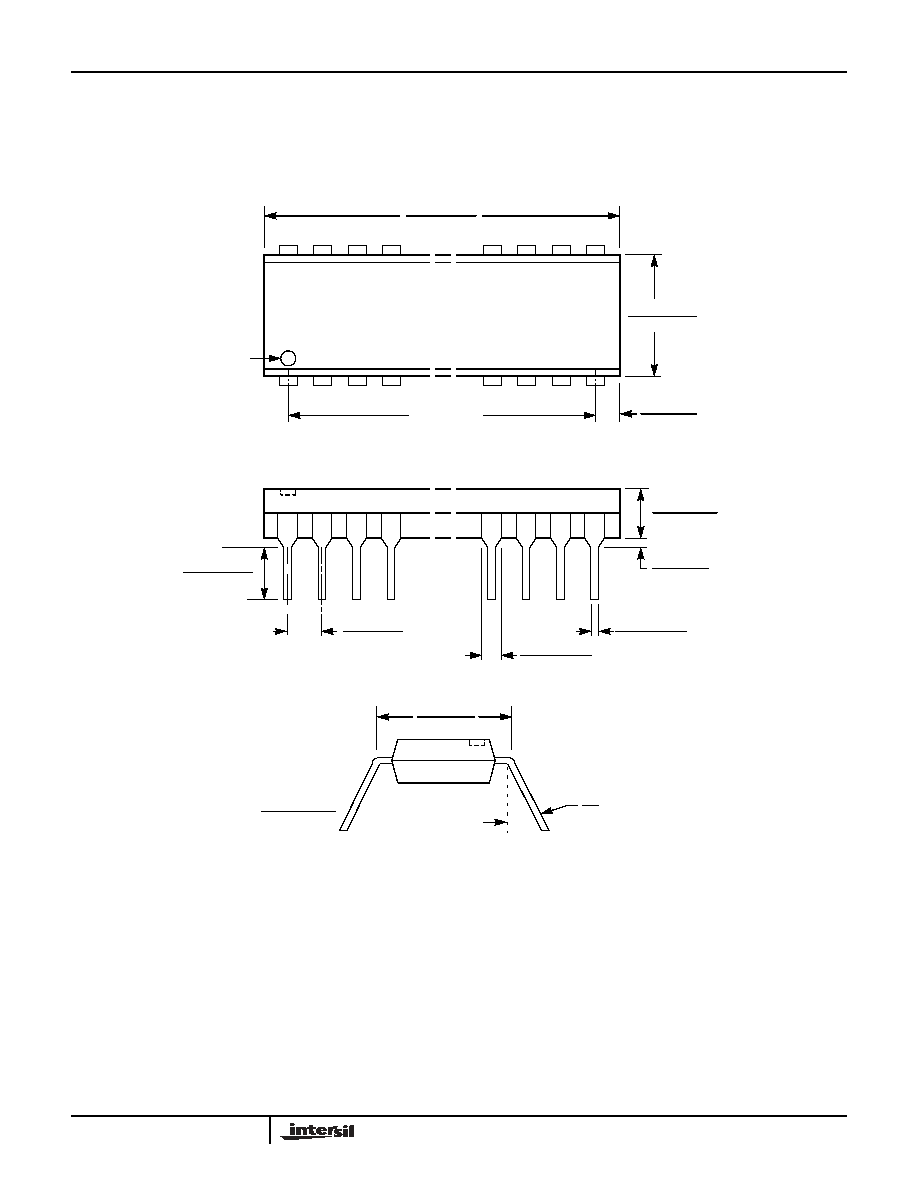
14
FN8163.1
September 14, 2005
PACKAGING INFORMATION
0.022 (0.559)
0.014 (0.356)
(3.81) 0.150
(2.92) 0.1150
0.10 (BSC)
(2.54)
1.060 (26.92)
0.980 (24.89)
0.900 (23.66)
Ref.
Pin 1 Index
0.195 (4.95)
0.115 (2.92)
≠≠
0.015 (0.38)
Pin 1
Seating
Plane
0.070 (1.778)
0.045 (1.143)
0.280 (7.11)
0.240 (6.096)
--
0.005 (0.127)
0∞
15∞
20-Lead Plastic Dual In-Line Package Type P
1. ALL DIMENSIONS IN INCHES (IN PARENTHESES IN MILLIMETERS)
2. PACKAGE DIMENSIONS EXCLUDE MOLDING FLASH
0.014 (0.356)
0.008 (0.2032)
0.300
(7.62) (BSC)
NOTE:
X9221A

15
All Intersil U.S. products are manufactured, assembled and tested utilizing ISO9000 quality systems.
Intersil Corporation's quality certifications can be viewed at www.intersil.com/design/quality
Intersil products are sold by description only. Intersil Corporation reserves the right to make changes in circuit design, software and/or specifications at any time without
notice. Accordingly, the reader is cautioned to verify that data sheets are current before placing orders. Information furnished by Intersil is believed to be accurate and
reliable. However, no responsibility is assumed by Intersil or its subsidiaries for its use; nor for any infringements of patents or other rights of third parties which may result
from its use. No license is granted by implication or otherwise under any patent or patent rights of Intersil or its subsidiaries.
For information regarding Intersil Corporation and its products, see www.intersil.com
FN8163.1
September 14, 2005
PACKAGING INFORMATION
0.290 (7.37)
0.299 (7.60)
0.393 (10.00)
0.420 (10.65)
0.014 (0.35)
0.020 (0.50)
Pin 1
Pin 1 Index
0.050 (1.27)
0.496 (12.60)
0.508 (12.90)
0.003 (0.10)
0.012 (0.30)
0.092 (2.35)
0.105 (2.65)
(4X) 7∞
20-Lead Plastic Small Outline Gull Wing Package Type S
NOTE: ALL DIMENSIONS IN INCHES (IN PARENTHESES IN MILLIMETERS)
0.420"
0.050" Typical
0.050"
Typical
0.030" Typical
20 Places
FOOTPRINT
0.010 (0.25)
0.020 (0.50)
0.015 (0.40)
0.050 (1.27)
0.007 (0.18)
0.011 (0.28)
0∞≠8∞
X 45∞
X9221A














